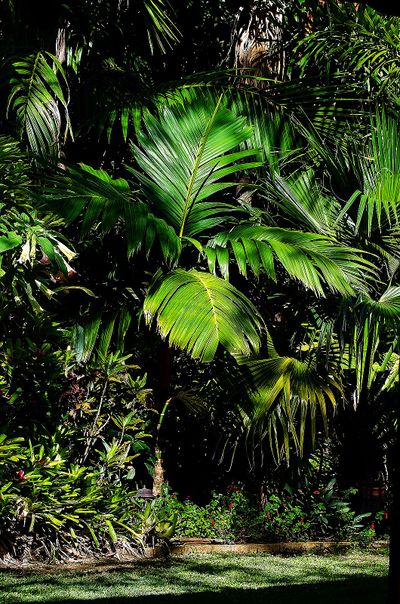Areca vestiaria
| Areca (ah-REHK-ah) vestiaria (vehs-tee-ahr-EE-ah) | |||||||
|---|---|---|---|---|---|---|---|
 Dennis Hundscheidt's Tropical Brisbane Garden, Australia. Photo by Daryl O'Connor. | |||||||
| Scientific Classification | |||||||
| |||||||
| Synonyms | |||||||
|
| |||||||
| Native Continent | |||||||
|
| |||||||
| Morphology | |||||||
| |||||||
| Culture | |||||||
|
| |||||||
| Survivability index | |||||||
|
| |||||||
| Common names | |||||||
|
| |||||||
Contents
Habitat & Distribution
Areca vestiaria grows naturally in low mountainous terrain up to an elevation of 1200 meters in the rain forests of eastern Indonesia, Maluku, Sulawesi.Description
It would be hard to find a more morphologically diverse species in the palm kingdom. This gorgeous palm varies from a profusely suckering red crownshafted plant with maroon leaves, to a single trunked orange version with green leaves, and everything in between. It has been reported that there is substantial color variation depending on elevation, with the more colorful plants coming from higher elevations. Observations, at least in cultivation, indicate the maroon variety suckers more readily than the orange form. Clumping individuals will attain widths up to 15 ft/4.5m and heights of 20-25 ft/6-8m. This palm will often times exhibit distinct arial or stilt roots emerging from the 3-4in/7-10cm. diameter trunks. These palms are monoeceious with small yellow/orange flowers emerging from beneath the crownshaft that bear orange to dark red ovoid fruit similar to Areca catechu. Editing by edric.
Culture
Although tropical in nature, this palm appears able to withstand periodic low temperatures, but will eventually succumb to persistent coolness, often times only surviving until January in the So. California winter. It could probably survive close to nightime freezing, if the days remained on the warm side, as is often the case in parts of Florida. They prefer a sheltered, consistently moist and humid location, with more shade in less humid environments. A rich well draining soil would appear to be the best. It fruits profusely at a young age, and the seeds volunteer easily. The rate of growth can be surprisingly quick when given suitable growing conditions. Cold Hardiness Zone: 10a.
Comments and Curiosities
Origin: Indonesia
Height: Up to 20’
Light: Filtered
Water: Keep moist
Bloom: Small, yellow, in clusters
Comments: Areca vestiaria grows naturally in low mountainous terrain up to an elevation of 3600 feet in the rain forests of eastern Indonesia. Clumping individuals will attain widths up to 15 feet and heights of 20-25 feet. This palm will often times exhibit distinct aerial or stilt roots emerging from the 3-4in/7-10cm. diameter trunks. These palms are monoeceious with small yellow/orange flowers emerging from beneath the crown shaft that bear orange to dark red ovoid fruit. They prefer a sheltered, consistently moist and humid location, with more shade in less humid environments. A rich well-draining soil would appear to be the best. (Excelsa Gardens)
- IMAGE GALLERY
External Links
- Glossary of Palm Terms
- MODERN BOTANICAL LATIN
- "Just To Be Clear"
- https://merwinconservancy.org/2015/10/palm-fact-of-the-week-areca-vestiaria-or-sunset-palm/
- http://www.excelsagardens.com/?p=2348
References
Phonetic spelling of Latin names by edric.
Special thanks to Geoff Stein, (Palmbob) for his hundreds of photos.
Special thanks to Palmweb.org, Dr. John Dransfield, Dr. Bill Baker & team, for their volumes of information and photos.
Glossary of Palm Terms; Based on the glossary in Dransfield, J., N.W. Uhl, C.B. Asmussen-Lange, W.J. Baker, M.M. Harley & C.E. Lewis. 2008. Genera Palmarum - Evolution and Classification of the Palms. Royal Botanic Gardens, Kew. All images copyright of the artists and photographers (see images for credits).
Many Special Thanks to Ed Vaile for his long hours of tireless editing and numerous contributions.










































































